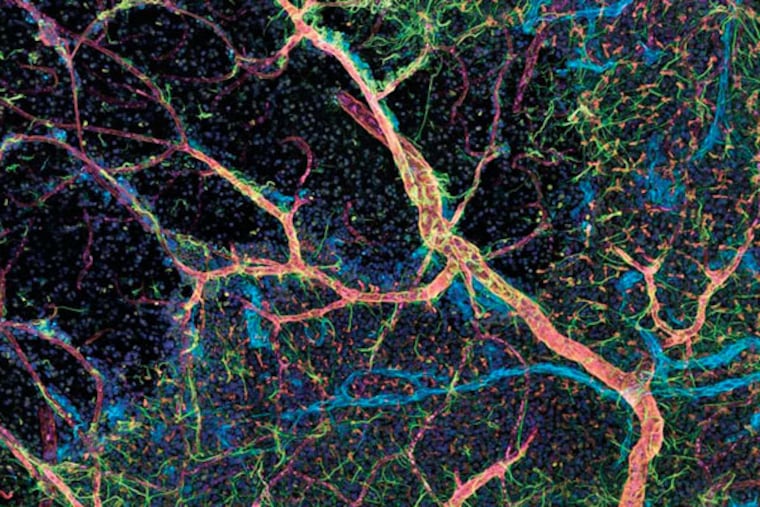The brain stays in the picture
The darkened room at Drexel University contains a 120-inch projection screen, a bunch of high-end 3-D glasses, and a custom-built computer with enough memory to make your laptop seem like a toaster oven.

The darkened room at Drexel University contains a 120-inch projection screen, a bunch of high-end 3-D glasses, and a custom-built computer with enough memory to make your laptop seem like a toaster oven.
State-of-the-art equipment, in other words, for racing through a fantasy world to gun down virtual foes.
Andrew R. Cohen and Eric Wait use it for something they find much more interesting: traveling through the brain of a mouse.
The Drexel engineers and their colleagues have applied video-game technology to let biologists analyze and watch movies of the formation of brain cells - though the phrase "watch movies" hardly does it justice.
Put on a pair of the glasses, and it feels as if you are right there, floating in the rodent's gray matter. Hey! Here's a blood vessel, its spidery branches supplying the brain with nutrients.
Over there, see the adult stem cell dividing in two? The mouse's brain is replenishing the neurons for its olfactory bulb, the freshly copied DNA a blur of ghostly green.
Pretty movies aside, the key is that the software keeps track of every cell in a slice of brain tissue - when it was created, how it changes shape, precisely where it travels and how fast. Important things to know if one is studying diseases that involve the loss of brain cells, such as Alzheimer's, or the disease that involves cell division run amok - cancer.
Funded by the National Institutes of Health, Cohen has made the software available free to any lab that wants it.
"We really try to get the tools in the hands of the biologists," said Cohen, an associate professor of electrical and computer engineering.
So far, just a few labs are starting to use the program, the latest version of which was described in an October study, but early reviews are positive.
A big champion is neuroscientist Sally Temple, scientific director of the Neural Stem Cell Institute, an independent research center in Rensselaer, N.Y. She has been working with Cohen for years to help him understand what biologists want to be able to do.
"It really enables us to understand our data in a new way," Temple said of the software. "We're really able to manage the data, extract information, analyze it, and test hypotheses in a way we just couldn't do before."
To make the movies, researchers at Temple's institute remove the brain of a mouse and cut out its subventricular zone, a region where neural stem cells are known to be actively dividing throughout the animal's life. This tissue is kept alive in an incubator and placed under a special microscope that detects fluorescent emissions.
The mice being studied have been genetically engineered so that their neural cells are "labeled" with green fluorescent protein and their blood vessels with red fluorescent protein. The microscope aims laser beams at the tissue and records the resulting fluorescent emissions as a movie.
That technique, cool as it sounds, has been around for years. What is new is the software's ability to track individual cells, potentially while dosing the tissue with different drugs.
In the case of Alzheimer's, Temple said, "if we can figure out how these cells are controlled, perhaps then we will be able to retain them longer and help prevent that loss."
Previously, a scientist looking at such movies would have to record the information about each cell by hand, eyeballing the progress of dozens of green blobs on a screen.
"It was laborious to the point that it was impossible," said Temple, a 2008 winner of a MacArthur fellowship.
Now, not only does the computer program handle the tracking, it also allows the scientist to zoom in on specific cells, pause the movie, and rotate the perspective, almost like the producer of a high-tech football telecast.
Or like someone steering a character through a video game.
Wait, a Ph.D. student in Cohen's lab, admits that he has used the lab's souped-up computing hardware to play an actual video game - one of the titles from the popular Batman: Arkham series. But he said it is more compelling to use the equipment to navigate real live biology.
"We enjoy the medical images more," Wait said.
In addition to helping craft the software, Wait also is the prime builder of the lab's dozen or so custom computers on which it runs.
Wait built the fanciest one to date at the end of last year, incorporating Intel's latest central processing unit the first week it came out. The machine boasts a whopping 512 gigabytes of random-access memory - 100 times what is in a typical home computer - along with a special system of radiators and fans to keep it cool.
He and Cohen use that machine to run experimental versions of the cell-tracking software.
But biologists need not worry: The latest publicly available version of the software runs on any good high-end, off-the-shelf machine, and Cohen is eager to help them use it.
Temple, the neuroscientist, calls it the era of "big data" for biology.
And she is convinced that the computer whizzes from Drexel can help make sense of it.
215-854-2430